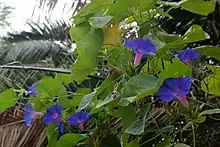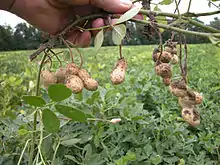Mixed mating systems
A mixed mating system (in plants), also known as “variable inbreeding” a characteristic of many hermaphroditic seed plants, where more than one means of mating is used.[1] Mixed mating usually refers to the production of a mixture of self-fertilized (selfed) and outbred (outcrossed) seeds. Plant mating systems (breeding systems) control genetic exchanges within and among individuals, and influence the evolution of plant species through gene flow, which affects the distribution of genetic variation within and among populations. Mixed mating systems are generally characterized by the frequency of selfing vs. outcrossing, but may include the production of asexual seeds through agamospermy.[2] The trade offs for each strategy depend on ecological conditions, pollinator abundance and herbivory[3] and parasite load.[4] Mating systems are not permanent within species; they can vary with environmental factors, and through domestication when plants are bred for commercial agriculture.[5]


Occurrence
Mixed mating systems occur in the majority of plant families. Examples of mixed mating systems in nature are impatiens, violets,[6] morning glory, and bamboo,[7] which are considered invasive in many regions. Mixed mating is common in many invasive species; part of their ability to spread vigorously is due to their ability to change mating strategies based on varying environmental factors, and pollinator presence. Common commercial crops utilizing mixed mating systems are the peanut plant,[8] avocados,[5] sorghum and cotton.[5]
Evolutionary models of stable mixed mating
Historically, Charles Darwin's experiments on selfing and out-crossing many plant species caused him to question any adaptive value of self-fertilization.[9][10] Early evolutionary models assumed inbreeding depression did not change, which increased the likelihood of stable mixed mating.
Ronald Fisher (1941) presented the idea that selfing plants had a genetic transmission advantage over outcrossing plants because selfed offspring would inherit two copies of the seed parent's genome instead of just one. His models solidified the idea of automatic selection for increased selfing.
David Lloyd (1979) developed phenotypic a model that showed that the conditions of automatic selection for selfing via pollinators was different from autonomous selfing, and predictive of stable mixed mating systems.[11]
Lande & Schemske (1985) introduced the idea that inbreeding depression, is not constant and evolves through purging of genetic load due to selection associated with selfing. They predicted that outcrossing as a mating strategy would resist increases in selfing frequencies due to inbreeding depression, but once inbreeding depression was reduced, selection due to the genetic transmission advantage would result in the production of only selfed seeds. Their model predicted that most plants would either be outcrossing or selfing.[12] The observation of large numbers of species with mixed mating contradicted this idea, and motivated others to develop models to explain the prevalence of mixed mating systems including ideas such as selective interference and pollen discounting.[8]
Mechanisms maintaining mixed mating systems
Mass Action Model – Holsinger's “mass action” model assumes that the proportion of selfed and out-crossed seeds produced is a function of rates of pollen transfer among plants and plant density. This model predicts that mixed mating can be a stable strategy when plants receive mixtures of self and out-cross pollen.[13]
Selective Interference –The genetic process of selective inference may prevent purging of genetic load and counterbalance the automatic selection of selfing.[6][8]
Cryptic Self-Incompatibility – A mechanism of reproductive assurance, pollen competition favors out-cross pollen resulting in complete out-crossing when pollinators are abundant, but allows for self-fertilization when pollen is limited.
Delayed Selfing – A mechanism providing reproductive assurance at a lower cost than autonomous selfing, when the anthers or stigma change position as the flower ages, bringing them into close proximity and promoting self-pollination.[14]
Reproductive Compensation – A result of more ovules than can mature into seeds, and the production of large numbers of seeds over the lifespan of a perennial plant, can contribute to the evolution of mixed mating systems. Rare selfed seedlings with higher fitness may decrease the fitness difference between selfed and out-crossed offspring.
Cleistogamy – Most plants producing cleistogamous (closed, selfing) flowers also produce chasmogamous (open, outcrossing) flowers, and consequently will typically produce mixtures of selfed and out-crossed seeds.
Components of the maintenance of mixed mating system also include self‐compatibility, especially autonomous self‐pollination, which can become particularly beneficial in human degraded habitats with less pollinators and increased pollen limitation.
References
- Goodwillie, Carol; Kalisz, Susan; Eckert, Christopher G. (2005). "The Evolutionary Enigma of Mixed Mating Systems in Plants: Occurrence, Theoretical Explanations, and Empirical Evidence". Annual Review of Ecology, Evolution, and Systematics. 36 (1): 47–79. doi:10.1146/annurev.ecolsys.36.091704.175539. ISSN 1543-592X.
- Richards, A. J. (1997), "Self-fertilization and inbreeding", Plant Breeding Systems, Springer US, pp. 357–395, doi:10.1007/978-1-4899-3043-9_9, ISBN 978-0-412-57440-5
- Campbell, Stuart A. (2015). "Ecological mechanisms for the coevolution of mating systems and defence". New Phytologist. 205 (3): 1047–1053. doi:10.1111/nph.13212. PMID 25729803.
- Hanley, Kathryn A. (1997). "Infection, polymorphism and evolution". Parasitology Today. 13 (7): 278. doi:10.1016/s0169-4758(97)87206-7. ISSN 0169-4758.
- Velázquez-López, Rebeca; Wegier, Ana; Alavez, Valeria; Pérez-López, Javier; Vázquez-Barrios, Valeria; Arroyo-Lambaer, Denise; Ponce-Mendoza, Alejandro; Kunin, William E. (2018-05-09). "The Mating System of the Wild-to-Domesticated Complex of Gossypium hirsutum L. Is Mixed". Frontiers in Plant Science. 9: 574. doi:10.3389/fpls.2018.00574. ISSN 1664-462X. PMC 5954804. PMID 29868048.
- Winn, Alice A.; Moriuchi, Ken S. (2009). "The maintenance of mixed mating by cleistogamy in the perennial violet Viola septemloba, Violaceae". American Journal of Botany. 96 (11): 2074–2079. doi:10.3732/ajb.0900048. ISSN 0002-9122. PMID 21622326.
- Xie, Ning; Chen, Ling-Na; Dong, Yu-Ran; Yang, Han-Qi (2019-10-11). "Mixed mating system and variable mating patterns in tropical woody bamboos". BMC Plant Biology. 19 (1): 418. doi:10.1186/s12870-019-2024-3. ISSN 1471-2229. PMC 6787975. PMID 31604418.
- Cruzan, Mitchell B., author. Evolutionary biology : a plant perspective. ISBN 978-0-19-088267-9. OCLC 1019837248.CS1 maint: multiple names: authors list (link)
- Darwin, Charles (1892). The effects of cross and self fertilisation in the vegetable kingdom /. New York: D. Appleton. doi:10.5962/bhl.title.51079.
- Darwin, Charles (1897). The different forms of flowers on plants of the same species / by Charles Darwin. New York: D. Appleton. doi:10.5962/bhl.title.26581.
- Lloyd, David G. (1979). "Some Reproductive Factors Affecting the Selection of Self-Fertilization in Plants". The American Naturalist. 113 (1): 67–79. doi:10.1086/283365. ISSN 0003-0147.
- Schemske, Douglas W.; Lande, Russell (1985). "The Evolution of Self-Fertilization and Inbreeding Depression in Plants. II. Empirical Observations". Evolution. 39 (1): 41. doi:10.2307/2408515. ISSN 0014-3820. JSTOR 2408515. PMID 28563649.
- Holsinger, Kent E. (1991). "Mass-Action Models of Plant Mating Systems: The Evolutionary Stability of Mixed Mating Systems". The American Naturalist. 138 (3): 606–622. doi:10.1086/285237. ISSN 0003-0147.
- Goodwillie, Carol; Weber, Jennifer J. (2018). "The best of both worlds? A review of delayed selfing in flowering plants". American Journal of Botany. 105 (4): 641–655. doi:10.1002/ajb2.1045. ISSN 0002-9122. PMID 29630718.